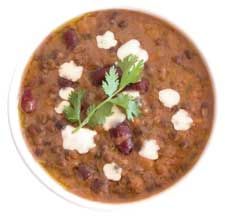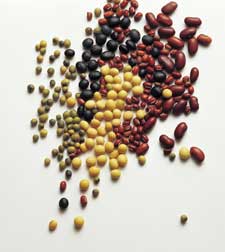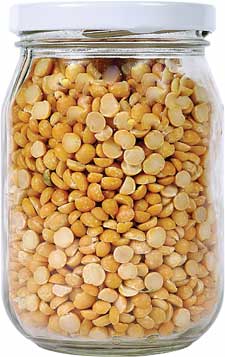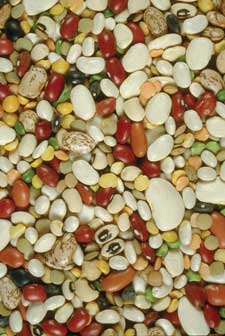Arts
The Magic Broth

It is the food of coolies and Gods, immigrants and nawabs...
From birth to marriage to death, if you are Indian, there is no escaping dal, the humble lentil which signifies life itself. Dal is one of the first solid foods a baby is fed and it is part of the funeral rituals when life ends and the soul takes flight.
In fact, you cannot even get married without dal! A Tamil phrase – paruppu illaada kalyanamaa? – puts it succinctly: “How can there be a wedding without dal?” Dals, better known as pulses or lentils, grow and are dried on the vine before being hulled and split, providing the building blocks for many fulfilling meals. They are part of the legume family, which also consists of beans and peas. In America, walk into any Indian grocery store and you see the push and pull of immigrant life, people fitting into their shopping baskets the aura of a lost world – bags of basmati rice, desi vegetables and always packets and packets of dal. Mainstream Americans would be shocked at the volume of lentils these new Americans consume, but then dal is so much more than mere food, it’s a link to loved ones left behind, to a fast vanishing way of life. Life without dal meant life without extended family. For new immigrants in a new world where everything seems disjointed and out of focus, a bowl of dal can gives life normalcy, The earliest Indian immigrants did not have the luxury of Indian groceries-on-demand as we have today and had to make do with strange, supermarket variety of lentils and chapattis conjured out of white flour. It was this lack of Indian dry goods that led so many entrepreneurs, especially those from Gujarat, to import ethnic foods from India.
For the millions of immigrants who have left India for the far corners of the world, dal remains a common shared experience. It would be hard to find an Indian who does not know the taste of dal, because it is one dish common to almost every regional cuisine in India. On days of celebrations as well as shraddhas or death ceremonies, uncles, aunts and cousins would gather together for the rituals and lunch. The main dish in the feast would be Sindhi besan curry, made from ground channa dal, which would be simmered for hours with kukum flowers and tamarind until the aroma seeped through the entire house. Even before the prayer ceremonies were over, the sizzling sound and fragrance of frying sana pakoras – chopped onions, coriander leaves and green chilies dipped in a batter of ground dal – would signal to all the young hungry cousins, dutifully bound by spiritual matters, that salvation was near at hand: lunch was about to be served! There’s a Hindi saying – Dal, dal bacheray pal – dal, the nurturer of children. Lentils come from the soil and there’s a down to earth goodness about them. Indeed, dal is surely the mother of all India, churned from the depths, the very womb of the earth, it sustains and satisfies. It is a staple food for the masses – the phrase dal roti signifies livelihood. Cooked with herbs and spices, it can be poetry for the soul, and when simmered in Moghlai style with cream and butter, it is a meal fit for emperors.
Lentils come in many varieties and colors – red, green, black, orange, yellow, brown and white with names like toovar, moong, channa, urad and masoor – and when cooked, these seeds form a rich vocabulary of different tastes, textures and fragrances. They also enrich the soil they grow in with nitrates, and farmers often use the same soil to grow other crops.
While rice and wheat have been primary foods,dals are an ancient food and have been very much a part of the Indian cuisine for thousands of years. A prayer in the Yajurveda, composed around 800 BC mentions lentils such as masura (masoor), mudga (mung), masha (urad) and klaya (matter). According to K.T. Achaya who wrote the seminal Indian Food: A Historical Companion, early Buddhist and Jain canonical literature first mentioned “new” pulses such as adhaki (tuvar), chanaka (chana) and alisandaga (which may be today’s kabuli chana and came from Alexandria). In those days pulses were eaten as soups (supa or yusa), vatakas (vadas) and parpatas (papads). Even the Gods favor dals. The mighty Tirupati temple dedicated to Lord Venkateshwara doles out thousands and thousands of laddus as prasadam every day made out of urad dal, sugar and nuts. The channa dal served in the mahaprasadam at the famous Jagganath Temple of Orissa to over 100,000 devotees a day along with other foods, is particularly well-known. Ask any immigrant and each will have a story about the memories dal evokes. One may remember amma’s steamy sambar, another may talk of the dal puri eaten in a wayside dhaba, and yet another of the special dal served in a childhood friend’s home. Dal was served at celebrations and religious ceremonies with many other celebratory foods, but dal was also there – cooked simply in a khichari, a mild porridge – when you were sick as a child and got to miss school. Dal was central to so many family meals, that in a way it signifies family togetherness and warmth. “Indians knew the versatility of legumes long before many civilizations even heard of them,” writes culinary expert Julie Sahni. “At the shradha, a Vedic Indian ritual paying homage to a dead relative, a feast consisting of several courses, all containing legumes, is still prepared in its full tradition today.” India may be a blend of different cultures, religions and colors, but almost every region of India agrees on one thing – dal. Each community may have its own methods of cooking it, but all share a fondness for its homey concoctions. In fact, there are families who eat dal every single day at every meal. Rich in protein, it has been the poor man’s sustenance, giving the energy needed for hard labor. For the many vegetarian cultures in India, dal is central to their diet.
Dals are a quick change artiste than can be transformed into many different foods from snacks to appetizers to soupy main courses and even desserts. In Classic Indian Cooking, Sahni explains that both urad (white split gram bean) and channa dal (yellow split peas) do double duty in south and southwestern India as a spice. These are generally cooked in oil with mustard seeds and used as a flavoring for dumplings and vegetable preparations. Channa dal is also ground to a powder or flour and used as a thickener in making sweet and fudge preparations, and even as batter for frying pakoras.
Almost every state has its own favorite version of dal, from the moong dal with black mustard seeds of the Maharashtra Brahmins, who do not use garlic, to the elaborate Lakhnawi Khatti dal, a rich classic from Lucknow, which Sahni describes as “fragrant with garlic and fresh ginger root and laced with black cumin seed flavored oil. The characteristic feature of this dal is the tamarind juice added to perk up the flavors and provide a tang.” Then there’s the kali dal, or buttered black beans, which is made from sabat urad, according to Sahni: “This is the most exquisite of all dal preparations, completely different both in texture and flavoring. This is a Moghul classic and the best is served in Bukhara in Mumbai and at Moti Mahal in Delhi. Prepared correctly, it can take over five hours to cook on a very slow fire so that the beans can cook and expand without breaking.” Urad, known as ma ki dal, or mother’s dal is very popular in Punjab. In fact, all sorts of dal find their way into Punjabi cuisine and dal chawal is the very epitome of comfort food, which can be eaten any time of the day or night. Sindhi cuisine also utilizes lentils in many of its vegetarian dishes, including a classic toovar dal preparation, Sindhi curry, which is made from chickpea flour, and the Sindhi saibhaji, a ratatouille of spinach, several other vegetables and channa dal. Gujarat, of course, is the absolute treasure house of lentil cooking – no wonder dal bhaat is such a common expression. “I can say this unequivocally,” notes Madhur Jaffrey in her book Flavors of India, “If there is an haute cuisine for vegetarians – ancient, traditional foods with astounding flavors and textures, all based on sound nutritional principles – it can be found in the Indian state of Gujarat.” She points out that whether it is khandavi, pasta rolls made out of cooked chick pea batter or handva, a cake made out of batter of pulses and vegetables, or the sev, or the diamonds of lentil flour known as dhokla, lentils play a big part in Gujarati cooking from appetizers to main course to dessert. One of the most versatile dal is channa dal, which can be mixed with vegetables, meats and grains and when ground into flour, it can be used to bind kebabs. Deep fried, channa and moong dal, can become tasty snacks. Soaked and ground, form the basis for dahi vadas, kachoris and vadas. Made into a batter, they transform into crisp savories like gatti, papdi and papads, especially popular in Rajasthan. The creative cooks of Indian regions have also turned the mundane dal into rich desserts such as besan barfi, mung dal sheera and churma laddus. Dal is absolutely vital to the cooking of the South and is used in many auspicious occasions and ancestral rites. We asked Dr. Vasudha Naayanan, Professor of Religion at the University of Florida and an expert cook, to walk us through the dal traditions of South India. Moong dal is used in many happy functions, such as the making of pongal and also the soaked moong offering on Sri Ram Navami, the birthday of Rama. While moong dal is cooked also for death and ancestral rituals, toovar dal is used at birth rituals and for auspicious occasions in a number of ways. Unless one happens to be in mourning, toovar dal is served daily. “Initially, as soon as they serve you the vegetables, rice and ghee, the cook or the person who is serving will ladle a large spoon of cooked plain toovar dal, which just has salt and turmeric in it. “This initial serving of plain dal at the side is to signal the “normalcy” and the auspicious nature of the day. This simple plain dal is called ilai paruppu or leaf-dal, hreferring to the first symbolic serving of dal on the banana-leaf plate from which one eats.” Dals play such an important part on the South Indian table that even the second course in a standard meal is white rice, mixed with rasam (from the Sanskrit rasa). There are dozens of variety of rasam, each delectably different in flavor from the other. Rasam is understandably known as saaru or essence in Kannada and saarru amudu, the nectar of the essence in Tamil. Yes, South Indians certainly take their dals very, very seriously! An interesting historical point is that it was rasam that was called Mulligatawny soup by the British and adapted by them. Mulligatawny is from the Tamil word Milagu Tanni or pepper water. “The very first solid food a baby is given is white rice, mixed soft with plain boiled toovar dal, with no spices,” says Narayan. “After the baby is a year old, we add a spoon of light, thin, rasam – the top clear part – to the rice and toovar dal to introduce the baby to normal cuisine. Rasam and rice is given when we are sick, this is the mildest food. In traditional houses, there would be a light dinner and one would skip sambar and have a moong dal dish and rasam.” Dals are part of every meal from breakfast to dinner. Urad dal is used in the making of idlis and dosais. A standard breakfast in Andhra Pradesh is Pesarattu, a dal dosa, and the South Indian Adai is a popular tiffin. Dals are also the magical ingredient in hundreds of chutneys called pacchadis in Andhra Pradesh and Podis (powder) with precise quantities of particular, dry roasted and ground. The “gun powder,” which can make you weep, is very popular in Andhra. Little wonder then that immigrants have carried their obsession for dal all over the world, be it Africa, Malaysia, Europe or the Caribbean. In the West Indies, the children of immigrants who left India 150 years ago still lovingly cook dal and have introduced their own creations: dal roti is a Trinidadian delicacy, which you will not find in India. The Gujaratis who settled in Africa many years ago ensured that lentils flourished in East and South Africa too, and today these are exported all over the world. Sahni points out, there are so many different kinds of legumes in the world and due to the composition of soil and local climate, even the same species of legume can taste quite different. Across the United States hundreds of Indian grocery stores stock a full variety of dal products, from spicy chevra mixes to dal kachoris to cooked dal fresh, frozen, canned and shelf-stabilized. Last year a poor harvest in India had dal lovers in a tizzy because shortages in the home market, prompted India to ban the export of dals.
The prices in the overseas market skyrocketed and Indian immigrants found themselves paying double the price for dal. Luckily the shortage didn’t cause the near revolution that occurred in India some years ago, following a shortage of onions, another big Indian addiction!
It may come as a surprise to many to learn that America actually exports lentils and legumes to India. Last year a hefty shipment of 700,000 tons of peas was sold to India. According to Peter Klaiber, Director of Marketing, USA Dry Pea & Lentil Council based in Moscow, Idaho, the largest trade with India is in peas, both yellow and green, which are used in dal preparations in the domestic market in India. “India grows more peas and more lentils and more chickpeas than any other country by far, but Indians eat more than they grow,” says Klaiber. “So they need to import some to make up for the shortfall, because, as you know, people are eating dal every day.” He points out that India also buys from other countries, including Canada and Australia. Indeed in spite of being one of the largest dal growers in the world, India is also the largest importer in the world. Many of its premium dals are exported to fulfill the needs of the overseas Indian market. So India imports beans and lentils from Turkey, Canada and Nepal to make up for all that it’s sending out to expatriate sons and daughters who are trying to conjure up a taste of home on foreign shores. Dal is both comfort food and food for celebrations. It also has a strange, magical quality. A bubbling cauldron of dal never seems to run out, and you can open up your kitchen to those who may drop in suddenly. It is surely one of the most popular foods among Indians on college campuses in the United States, where a roomful of hungry foreign students, cooking up a pot, can get a taste of home and still not bust their budgets. So dal is probably the fuel which keeps India and Indians ticking. Whether you’re hungry, tired or depressed, a steaming bowl of dal will set you right. |






You must be logged in to post a comment Login